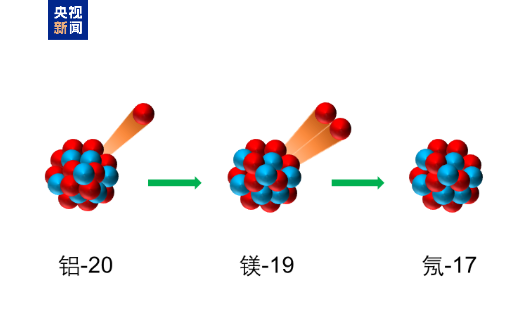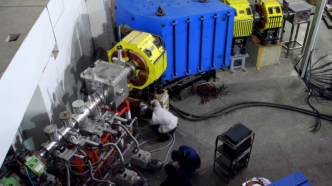
The reporter learned from the Institute of Modern Physics of the Chinese Academy of Sciences that recently, researchers from the institute and domestic and foreign collaborators such as the Helmholtz Center for Heavy Ion Research in Germany and Fudan University have made new progress in the research of strange decay of atomic nuclei. For the first time, a new nuclide aluminum-20 was observed experimentally and found to decay through a rare three-proton emission mode. The relevant research results were recently published in the academic journal Physical Review Letters (PRL).
In this study, researchers used the in-flight decay experiment technique based on the fragment separator device of the German Helmholtz Center for Heavy Ion Research to measure the angular correlation of the decay products of aluminum-20 (i.e., three protons and the remaining nucleus neon-17), and observed for the first time the three-proton emission phenomenon of the new nuclide aluminum-20. Aluminum-20 is located outside the proton drip line and has seven fewer neutrons than the stable aluminum isotopes in nature. It is the lightest aluminum isotope discovered experimentally so far.

Schematic diagram of aluminum-20 triple proton emission
Further research shows that aluminum-20 is the first three-proton emitting nucleus with "daughter nucleus" diproton radioactivity discovered experimentally. There is isospin symmetry breaking in the mirror-image nuclear system of aluminum-20 and nitrogen-20.
This study has deepened our understanding of the proton emission phenomenon and is of great significance for finding the limits of nuclear existence and understanding the structure and decay of nuclei outside the proton drip line.
At present, more than 3,300 nuclides have been discovered, of which less than 300 are stable nuclides naturally existing in nature, and the rest are unstable nuclides that will undergo radioactive decay. Common decay modes include α decay, β- decay, β+ decay, electron capture, γ transition, and fission, which were discovered before the middle of the 20th century.
Over the past half century, with the development of nuclear physics experimental equipment and detection technology, scientists have discovered a variety of new decay modes in the decay research of atomic nuclei far from the stable line. In the 1970s, researchers first observed the decay phenomenon of atomic nuclei spontaneously emitting protons, namely single proton radioactivity. After entering the 21st century, they discovered a peculiar decay mode in which extremely neutron-deficient atomic nuclei simultaneously emitted two protons, namely diproton radioactivity. In recent years, experiments have successively observed even rarer decay phenomena such as three-proton, four-proton and even five-proton emission. These peculiar decay modes provide important spectroscopic means for studying the structure of atomic nuclei far from the stable line.
- SRkaQcuYMGNNudG07/23/2025
- RwQPdXKoRgbxGV07/23/2025
- shLMFbIjfsZpuQr07/22/2025
- EzFTEudAR07/22/2025
- iijkvEOwCmBZeT07/22/2025
